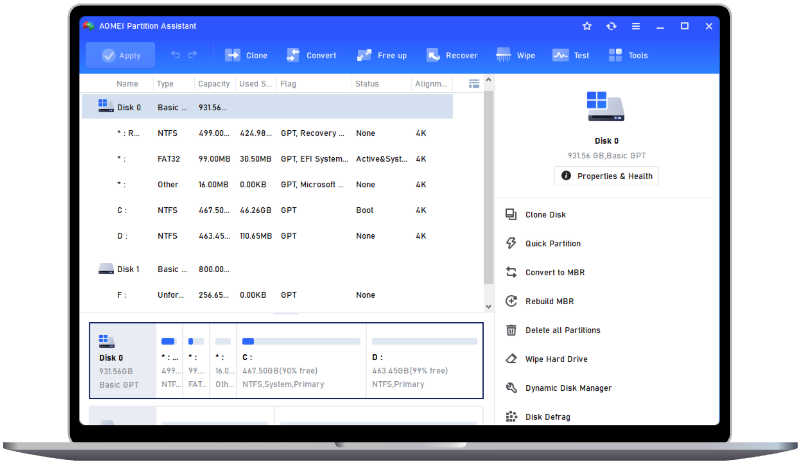How to Fix Windows Shrink Partition Too Small in Windows 10 and 11?
Windows shrink partition too small will lead to the shrink process failure. You can read to get solutions about how to shrink volume less than free space in this passage.
Why does Windows shrink partition too small happen?
When using Disk Management to shrink a partition, you might encounter an issue where the available shrink space seems too small. This can happen in two common scenarios:
- Limited Shrink Space Displayed: Disk Management shows only a small amount of space available to shrink, even though the partition has plenty of free space.
- Error Message During Shrinking: Disk Management indicates enough space to shrink but fails with an error stating, "There is not enough space available on the disk to complete this operation." This issue is most often seen with the system partition.
The problem occurs because Disk Management may not reflect the current status of the partition. This discrepancy can happen if other applications have modified the partition after Disk Management was opened. As a result, the information shown in Disk Management is outdated, leading to errors when you try to shrink the partition.
Another common cause is the presence of unmovable files in Windows 10 and 11, such as page files or locked system files, located in the middle or end of the partition. These files prevent Disk Management from freeing up enough contiguous space to complete the shrink operation.
You may also encounter similar errors when performing other tasks like extending or deleting a volume in Disk Management. If Disk Management shows less shrink space than expected or fails with a "not enough space" error, you can try using Diskpart, a command-line utility, as an alternative solution. Diskpart provides more flexibility and can help overcome some of the limitations of Disk Management.
How to fix Windows shrink partition not enough space issue?
In most cases, you can fix this issue by simply clicking the “Rescan Disks” option under the Action tab. After the partitions and volumes are reloaded, you should be able to shrink the volume or perform other operations. But if it fails, you can also try these 2 methods to fix shrink volume not enough space on disk partition issue in Windows 10 and 11.
Fix 1. Use a handy tool
Since command lines can be tricky for some users, we recommend trying an easier option first before turning to Diskpart. AOMEI Partition Assistant is a simple and effective partition manager with lots of useful features. If you run into the "not enough space" issue when shrinking a volume in Disk Management, this could be the perfect alternative.
With its 1-Click Adjust Space feature, AOMEI Partition Assistant makes it easy to manage free space on your disks. You can quickly resize partitions by simply dragging their edges, which makes adjusting your disk layout fast and effectively. Besides, you can even adjust multiple partitions at the same time, streamlining the whole process.
The Best Windows Disk Partition Manager and PC Optimizer
Step 1. Install and launch AOMEI Partition Assistant. Right-click a partition (here is D: partition) you want to adjust space and select "1-Click Adjust Space".
Note: It cannot select unallocated space to adjust because the feature is just for partition space adjustment. If there is unallocated space and you want to use it to expand a partition, you can use the feature "Merge Partition".
Step 2. If you want to use the space on F: to expand D: you can simply drag the dot near the partition F: head backward to shrink the partition F: and enlarge the partition D: simultaneously. Then click "OK". You can simultaneously drag the dot near the partition C: tail forward to shrink the partition C: so the D: will also be enlarged with the space of C: at the same time. In this case, you can adjust all partition space (C:, D:, and F:) on the disk.
Step 3. You can preview the operation by viewing the "Pending Operations". To commit the "Pending Operations", please click "Apply" and "Proceed".
Step 4. The process will start and you can check the progress. It might take time to finish the operation.
Step 5. Wait for the operation to be finished. After it is completed successfully, you will find D: is enlarged and both D: and F: are adjusted.
Fix 2. Shrink volume less than free space with Diskpart
To open the Diskpart utility, simply type “diskpart” in the Run box and press Enter, or you can run the command in a regular Command Prompt. Then, you can use the following commands to shrink a volume, pressing Enter after each one:
● list volume -All partitions on your PC will be listed.
● select volume x - x represents the partition you want to shrink.
● shrink desired=z - z refers to the size to be shrunk.
If you don't specify a size when shrinking a partition, Disk Management will try to shrink it by the maximum amount of space available. However, you might encounter an error saying that the shrink size is too large and would make the partition smaller than its minimum allowed size. This happens because the partition can only be reduced to the point where the first unmovable or locked file is located, as indicated by the warning in Disk Management.
To help with this, you can defragment the volume to free up a bit more space for shrinking. Additionally, temporarily turning off System Restore points may also help. If you're still unable to shrink the partition as much as you want, using a third-party partition manager like AOMEI Partition Assistant could be a good solution.
The Best Windows Disk Partition Manager and PC Optimizer
Conclusion
Windows shrink partition too small error when shrinking a partition in Windows is often caused by unmovable system files or outdated partition information. While Disk Management can sometimes be limited, there are several ways to address the issue. You can try simple fixes like rescanning disks, or you can use third-party tools such as AOMEI Partition Assistant for a more user-friendly experience. For those comfortable with command lines, Diskpart offers a more flexible solution. If all else fails, following the right steps to disable system files or using a reliable partition manager will help you successfully shrink your partition to the desired size. Windows users please turn to AOMEI Partition Assistant Server edition.


